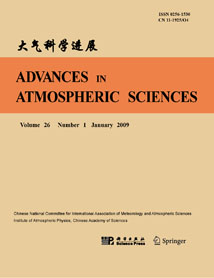| [1] |
Wang Huijun,
2000: The Interannual Variability of East Asian Monsoon and Its Relationship with SST in a Coupled Atmosphere-Ocean-Land Climate Model, ADVANCES IN ATMOSPHERIC SCIENCES, 17, 31-47.
doi: 10.1007/s00376-000-0041-6
|
| [2] |
LI Hongmei, FENG Lei, ZHOU Tianjun,
2011: Multi-model Projection of July--August Climate Extreme Changes over China under CO$_{2}$ Doubling. Part I: Precipitation, ADVANCES IN ATMOSPHERIC SCIENCES, 28, 433-447.
doi: 10.1007/s00376-010-0013-4
|
| [3] |
Xiaodan Wu, Cao Hongxing, Andrew Flitman, Wei Fengying, Feng Guolin,
2001: Forecasting Monsoon Precipitation Using Artificial Neural Networks, ADVANCES IN ATMOSPHERIC SCIENCES, 18, 950-958.
doi: 10.1007/s00376-997-0014-0
|
| [4] |
LI Hongmei, FENG Lei, ZHOU Tianjun,
2011: Multi-Model Projection of July--August Climate Extreme Changes over China under CO2 Doubling. Part II: Temperature, ADVANCES IN ATMOSPHERIC SCIENCES, 28, 448-463.
doi: 10.1007/s00376-010-0052-x
|
| [5] |
Guo Yufu, Yu Yongqiang, Liu Xiying, Zhang Xuehong,
2001: Simulation of Climate Change Induced by CO2 Increasing for East Asia with IAP/LASG GOALS Model, ADVANCES IN ATMOSPHERIC SCIENCES, 18, 53-66.
doi: 10.1007/s00376-001-0004-6
|
| [6] |
CAO Jian, Bin WANG, Baoqiang XIANG, Juan LI, WU Tianjie, Xiouhua FU, WU Liguang, MIN Jinzhong,
2015: Major Modes of Short-Term Climate Variability in the Newly Developed NUIST Earth System Model (NESM), ADVANCES IN ATMOSPHERIC SCIENCES, 32, 585-600.
doi: 10.1007/s00376-014-4200-6
|
| [7] |
FANG Yongjie, ZHANG Yaocun, HUANG Anning, LI Bo,
2013: Seasonal and Intraseasonal Variations of East Asian Summer Monsoon Precipitation Simulated by a Regional Air-Sea Coupled Model, ADVANCES IN ATMOSPHERIC SCIENCES, 30, 315-329.
doi: 10.1007/s00376-012-1241-6
|
| [8] |
Feng Guolin, Cao Hongxing, Gao Xinquan, Dong Wenjie, Chou Jifan,
2001: Prediction of Precipitation during Summer Monsoon with Self-memorial Model, ADVANCES IN ATMOSPHERIC SCIENCES, 18, 701-709.
|
| [9] |
Ding Yuguo, Tu Qipu, Wen Min,
1995: A Statistical Model for Investigating Climatic Trend Turning Points, ADVANCES IN ATMOSPHERIC SCIENCES, 12, 47-56.
doi: 10.1007/BF02661286
|
| [10] |
Chong-yu XU, Lebing GONG, JIANG Tong, Deliang CHEN,
2006: Decreasing Reference Evapotranspiration in a Warming Climate—A Case of Changjiang (Yangtze) River Catchment During 1970–2000, ADVANCES IN ATMOSPHERIC SCIENCES, 23, 513-520.
doi: 10.1007/s00376-006-0513-4
|
| [11] |
ZENG Xinmin, ZHAO Ming, SU Bingkai, TANG Jianping, ZHENG Yiqun, GUI Qijun, ZHOU Zugang,
2003: Simulations of a Hydrological Model as Coupled to a Regional Climate Model, ADVANCES IN ATMOSPHERIC SCIENCES, 20, 227-236.
doi: 10.1007/s00376-003-0008-5
|
| [12] |
Min WEI,
2005: A Coupled Model Study on the Intensification of the Asian Summer Monsoon in IPCC SRES Scenarios, ADVANCES IN ATMOSPHERIC SCIENCES, 22, 798-806.
doi: 10.1007/BF02918680
|
| [13] |
Alexey V. ELISEEV, Igor I. MOKHOV,
2011: Uncertainty of Climate Response to Natural and Anthropogenic Forcings Due to Different Land Use Scenarios, ADVANCES IN ATMOSPHERIC SCIENCES, 28, 1215-1232.
doi: 10.1007/s00376-010-0054-8
|
| [14] |
Wu Guoxiong,
1988: MOUNTAIN TORQUE AND EXTERNAL FORCING, ADVANCES IN ATMOSPHERIC SCIENCES, 5, 141-148.
doi: 10.1007/BF02656776
|
| [15] |
Dorina CHYI, Zuowei XIE, Ning SHI, Pinwen GUO, Huijun WANG,
2020: Wave-Breaking Features of Blocking over Central Siberia and Its Impacts on the Precipitation Trend over Southeastern Lake Baikal, ADVANCES IN ATMOSPHERIC SCIENCES, 37, 75-89.
doi: 10.1007/s00376-019-9048-3
|
| [16] |
Liu Hui, Zhang Xuehong,
1999: A Study of SST Warming Trend in the Western Equatorial Pacific in a Coupled Ocean-Atmosphere-Land GCM, ADVANCES IN ATMOSPHERIC SCIENCES, 16, 24-30.
doi: 10.1007/s00376-999-0002-7
|
| [17] |
Zeng Qingcun, Dai Yongjiu, Xue Feng,
1998: Simulation of the Asian Monsoon by IAP AGCM Coupled with an Advanced Land Surface Model (IAP94), ADVANCES IN ATMOSPHERIC SCIENCES, 15, 1-16.
doi: 10.1007/s00376-998-0013-9
|
| [18] |
Dan Li, Ji Jinjun, Li Yinpeng,
2002: Climate Simulations Based on a Different-Grid Nested and Coupled Model, ADVANCES IN ATMOSPHERIC SCIENCES, 19, 487-499.
doi: 10.1007/s00376-002-0081-1
|
| [19] |
FU Weiwei, ZHOU Guangqing, WANG Huijun,
2006: Modeling the Tropical Pacific Ocean Using a Regional Coupled Climate Model, ADVANCES IN ATMOSPHERIC SCIENCES, 23, 625-638.
doi: 10.1007/s00376-006-0625-x
|
| [20] |
YU Yongqiang, ZHI Hai, WANG Bin, WAN Hui, LI Chao, LIU Hailong, LI Wei, ZHENG Weipeng, ZHOU Tianjun,
2008: Coupled Model Simulations of Climate Changes in the 20th Century and Beyond, ADVANCES IN ATMOSPHERIC SCIENCES, 25, 641-654.
doi: 10.1007/s00376-008-0641-0
|















 AAS Website
AAS Website 
 AAS WeChat
AAS WeChat 
 DownLoad:
DownLoad: